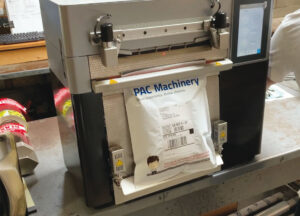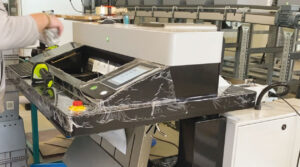How SLAM Completes Your Picking Operations
Don’t overlook your final 100 feet.
Contributed by: MHI’s SLAM Industry Group

SLAM equipment allows companies to move, label, scan and sort a variety of packages. Image courtesy of MHI’s SLAM Group.
The pandemic served as a massive accelerator of e-commerce operations. When retail stores shuttered, people turned online for their shopping needs. Even as we emerge from the pandemic, however, that genie isn’t going back in the bottle. Americans changed their shopping habits for good, and e-commerce continues to be the backbone of buying habits.
In the wake of that shift, warehouses all over the country have expanded their fulfillment centers. These new facilities represent a more highly automated operation. Companies have invested in equipment, automation and software aimed to move products quickly and efficiently from one end of the warehouse to the other. Operators use equipment like pick-to-light, conveyors, palletizers, sorters, robots and more to pull products from shelves and send them on their way.
While the focus on picking operations and its subsequent investment in tools to streamline the process is essential, it’s only at its best if its feeding into an automated SLAM system. Scanning, Labeling, Applying and Manifesting represents the final 100 feet of an operation. If overlooked and not automated as well, it can be the bottleneck that keeps you from quickly and accurately moving products out the door. “It’s a three-legged stool,” says Patrick Hanrahan, Sales Engineer with Numina Group. “Pick, pack and ship should represent a continuous flow, removing as many touches as possible from the processes.”
To fully leverage all that tech investment in your picking operations, you must also automate your SLAM operations. Completely integrating the pick, pack and ship areas and creating that full, three-legged stool is the answer to seamless fulfillment.
The case for automating SLAM

Optimizing the areas that will pay off the fastest is the best approach to automating the final 100 feet of a warehouse operation. Image courtesy of MHI’s SLAM Group.
Many companies remain behind the eight-ball when it comes to automating SLAM, which prevents them from fully optimizing their picking and fulfillment operations. “Companies sometimes begin manually and just continue that way,” says Greg Berguig, Vice President for PAC Machinery. “They’ll pick products, put them in totes and send them onto SLAM, where they must be scanned again and then labeled by hand.”
There are many reasons behind this lack of moving toward automated SLAM operations, including oversight, desire to reduce capital investment, or seasonality of operations. “Companies with big fluctuations in demand from one season to another sometimes hesitate to automate their SLAM operations, for fear the investment will go to waste,” Berguig explains. “Instead, they hire temporary labor during busy seasons.”
But the cost of bringing on temps or holding back on the initial expense associated with SLAM equipment is high. A better approach is automating this part of the warehouse. It will increase productivity, reduce errors and prevent bottlenecks.
How to go about automating SLAM areas varies, depending on the individual operation. “You don’t have to go all-in right out of the gate,” says Zach Hegerty, Product Manager of ModSort at Regal Rexnord. “Some customers automate step by step. The priority is to optimize the areas that will pay off fastest.”
You also don’t need to invest in the biggest, most expensive part of SLAM out of the gates, especially if it doesn’t make sense for your operations. “You don’t need to put in a full-blown, multi-million-dollar system, for instance,” says Hegerty. “It can be very introductory level.”
But even that will help with the integration between picking, packing and shipping. You’re after the most ROI for your specific operation. If, for instance, you have a fully staffed picking operation but can’t find the needed labor for SLAM, it makes sense to invest in automated SLAM equipment.
It’s important to also be as flexible as possible with the SLAM equipment you add, allowing for changing operations down the line. “SLAM will see a huge variety of packages moving through, so it’s important to have the ability to move, label, scan and sort all types,” Hegerty points out.
When investing in SLAM equipment to optimize picking, you’ll want to keep space constraints in mind, as well. Beth Mueller, Marketing Manager at PFlow Industries, says. that adding a vertical reciprocating conveyor (VRC) within the SLAM area can help in this regard. “If you’re storing packing materials and supplies on a mezzanine in your SLAM space, a VRC is a safe and efficient way to access this area,” she explains. “VRCs can operate within a smaller footprint than forklifts and are more cost-effective to install and maintain than elevators,” says Mueller.
VRCs also provide an added level of safety to your SLAM operations. “Unlike forklifts, VRCs have an enclosed carriage, preventing the materials being lifted and lowered from falling and injuring staff or damaging product and equipment,” says Mueller.
One final, necessary piece of automation to ensure the seamless integration of picking with SLAM is the software you’ll be using. “Sometimes customers begin with a paper-directed operation, and that won’t get you there,” says Hanrahan. “You need the right WES-WCS software systems that can control the processes.”
When you combine all the pieces from picking through shipping, SLAM can significantly enhance your productivity. Compare a manual operation–which typically results in processing 1.5 boxes per minute—to an automated system, where you can expect to send through anywhere from 15 to 60 boxes or bags per minute, depending on how automated your operations are.
At the end of the day, says Hanrahan, automated SLAM operations provide a completed picture to your picking operations, which is a compelling argument. “You’ll reduce shipping costs, automatically capture weights and dimensions, ensure you’re paying the right amount for manifesting and reduce errors,” he says. “Without it, you risk losing customers.” WMHS
About the Contributors
MHI’s SLAM Industry Group (www.mhi.org/slam) provides education and thought leadership for “the last 100 feet” of warehouse and distribution operations. The group is made up of the companies that make the solutions and technologies that go into ecommerce fulfillment processes.



